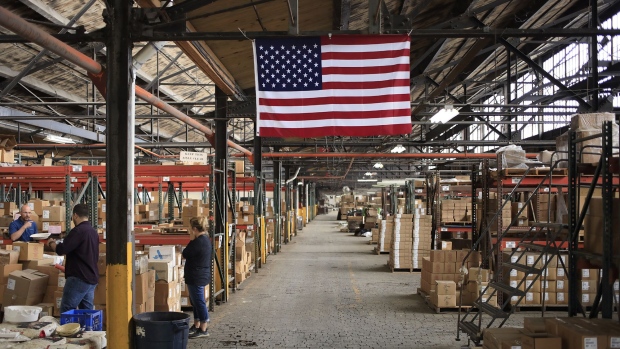Feb 1, 2023
US Factory Gauge Falls for Fifth Month to Lowest Since May 2020
, Bloomberg News

(Bloomberg) -- The US manufacturing downturn deepened last month, fueled by a further pullback in orders and factory production.
The Institute for Supply Management’s gauge of factory activity fell for a fifth straight month in January to 47.4, the weakest since May 2020 and less than the median estimate in a Bloomberg survey of economists. Readings below 50 indicate contraction.
The latest data — released Wednesday — underscore how a combination of rising interest rates, waning demand for merchandise, and economic uncertainty are weighing on factory activity.
The ISM gauges of both orders and production slipped further into contraction territory in January, also falling to their lowest levels since mid-2020.
Fifteen manufacturing industries reported contraction last month, led by wood products, textiles, paper products and furniture. Only two — miscellaneous manufacturing and transportation equipment — reported growth.
Meanwhile, the snarled supply chains that haunted factories in recent years continue to improve. That, paired with moderating demand both at home and abroad, has helped alleviate backlogs and shorten delivery times.
The reading “reflects companies slowing outputs to better match demand in the first half of 2023 and prepare for growth in the second half of the year,” Timothy Fiore, chair of ISM’s Manufacturing Business Survey Committee, said in a statement.
Select Industry Comments
- “Business is still strong, but we have begun to see softening in some pricing, and lead times seem to be improving.” — Computer & Electronic Products
- “Conditions are reasonable. Sales are a little better than planned. Cost pressures are easing for most products... The crystal ball remains a little blurry for the rest of 2023.” — Chemical Products
- “Sales have dropped (as expected) at the beginning of the year. Forecast from the sales department is showing even lower sales then we expected.” — Food, Beverage & Tobacco Products
- “Supply chain issues continue to plague our production schedules...Lead times have doubled for critical electronics, gaskets, sealants, and specialized steel.” — Transportation Equipment
- “Some business segments showing demand softening globally. Many materials showing improved lead times as well as cost deflation.” — Electrical Equipment, Appliances & Components
- “Thus far, the outlook for the first half of 2023 looks very soft. Demand for our products has taken a sharp downward turn...It seems everyone is bracing for a recession.” — Fabricated Metal Products
- “Customers are being quite aggressive in pursuing price decreases, far beyond the price relief we are actually receiving from our suppliers.” — Miscellaneous Manufacturing
On Tuesday, heavy-equipment maker Caterpillar Inc. posted lower-than-expected quarterly profit and said that sales in China will be softer this year.
The ISM’s measure of prices paid for materials increased for the first time in nearly a year, to 44.5. However, the figure still suggests easing inflationary pressures.
The employment measure indicated a modest increase in headcount in the month. That’s consistent with economists’ median forecast of 6,000 more manufacturing jobs in Friday’s employment report. Across the economy, forecasters predict payrolls increased by 190,000 in January.
“Panelists’ companies are indicating that they are not going to substantially reduce head counts as they are positive about the second half of the year,” Fiore said.
--With assistance from Kristy Scheuble.
(Adds graphic and select industry comments)
©2023 Bloomberg L.P.





